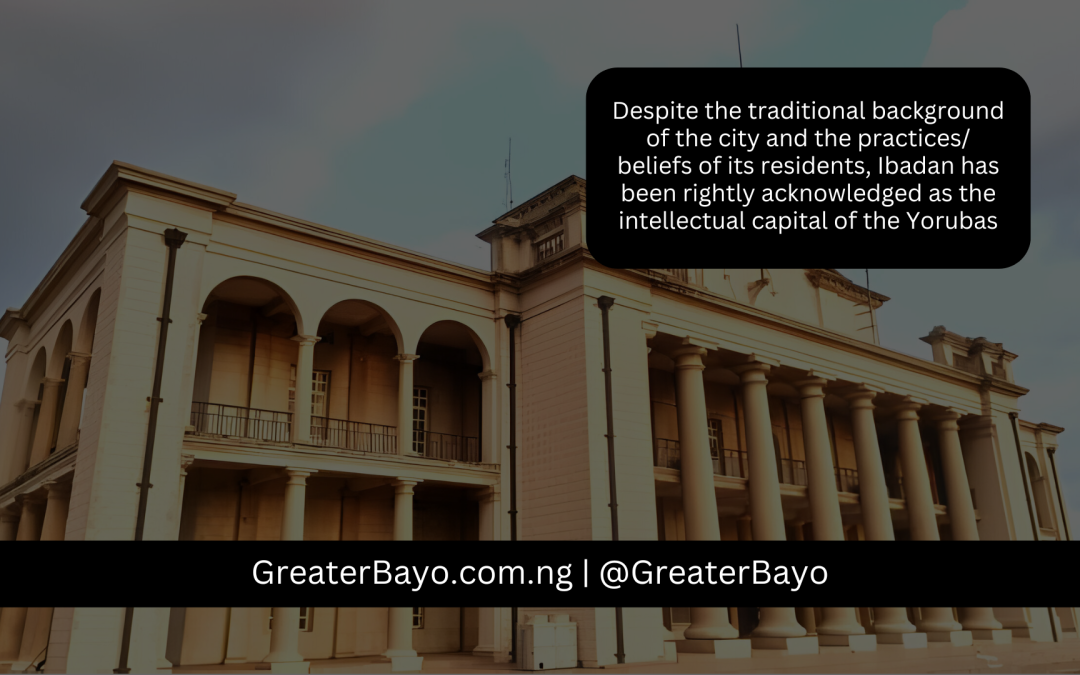More than 15 years ago, I met an Italian who had lodged at KS Motel at Total Gardens, Ibadan. He was in Ibadan for the first time and was very fascinated with the city when I informed him that Rome and Ibadan shared a unique similarity: both were built on seven hills. He asked me to take him around Ibadan which I did.
The seven hills are Oke Padre, Oke Ado, Oke Bola, Oke Mapo, Oke Are, Oke Sapati and Oke Mokola. But Ibadan is not just a city of hills. It is also a city of ‘bottoms’. Loosely translated, ‘idi’ means bottom or the backside. Several people have attached sexual innuendoes to the names. However, the actual translation indicates that some of the ‘idis’ indicate how the settlers converged at a point thereby leading to how they arrived at the names given. Go round the city and you can locate Idi-Arere, Idi-Ose, Idi-Ishin, Idi-Ape, Idi-Ayunre, Idi-Obi and Idi-Ito.
For instance, Idi-Arere is a location where the early settlers converged and held meetings under an ‘Arere’ tree. The actual full name is Idi- Igi Arere (under the Arere (obeche) tree). Idi-Arere is located between Oja-Oba and Molete. Idi-Ose, which should actually be Idi-Igi Ose (under the Ose (baobab) tree), is located around Ojoo/Moniya Road. Idi-Ishin is located around Jericho GRA area and was named after the Ishin (ake apple) tree. Idi-Ape is located at the intersection of Iwo Road and Bashorun and was named after the Ape tree. Idi-Ayunre which is located at the outskirts of the city on the way to Ijebu-Ode was named after the Ayunre (Albizia Zygia) tree.
Idi-Obi was named after the kola nut tree. Ditto for Idi-Ikan and Idi-Ito.
Ibadan is also a city with several junctions popularly called ‘Orita’. In Yoruba mythology, these ‘oritas’ or junctions are places where sacrifices are offered. Popular oritas in Ibadan are Oritamefa–a junction that leads to six roads (around UCH), Oritamerin ( a junction that leads to four roads), Orita Aperin, Orita Challenge and Orita Bashorun. Some of the names have been shortened nowadays with Orita Bashorun now simply referred to as Bashorun, Orita Challenge now Challenge and Orita Aperin simply Aperin.
Ibadan is still steep in its traditional beliefs though modernity is fast catching on. One of such is the still very popular egungun masquerade festival which usually takes place around June and July. Share on X
And still talking names, several names in Ibadan have their origin in the inability of the residents to pronounce the original names correctly. For example, the place popularly called Oke-Sapati was originally called Shepherd’s Hill but the illiterate residents couldn’t pronounce ‘Shepherd’s Hill’ and it was corrupted to Sapati. That was how it sounded to the ears of the residents at that time. The story behind Kudeti is quite interesting. A river runs around that area and the British District Officer during the colonial era was quite shocked at how dirty the river was. The river served the residents as they washed, bathed, defecated and drank the water. The DO therefore exclaimed, “This water is TOO DIRTY”. The illiterate residents now corrupted the words ‘too dirty’ to Kudeti.
Ibadan is still steep in its traditional beliefs though modernity is fast catching on. One of such is the still very popular egungun masquerade festival which usually takes place around June and July. When I was younger, this period was a period of fear mixed with excitement. Everyone wants to catch a glimpse of the Oloolu masquerade- except women who are forbidden to see it. Oloolu is the most popular and the most feared. I’ve seen it once before carrying what looked like a flat tray with several items on it.
Several years ago, there was a clash between a very popular Muslim cleric now late, called Ajagbemokeferi and Oloolu. It was rumoured then that Ajagbemokeferi disrobed and unveiled Oloolu. Then, there is Alapansapa. Alapansapa is the second most feared masquerade after Oloolu. Alapansapa dresses very smartly in bright colours. Even though most masquerades are associated with canes and whips, it is more so with Alapansapa. There is also Atipako and Abidielege.
Despite the traditional background of the city and the practices/ beliefs of its residents, Ibadan has been rightly acknowledged as the intellectual capital of the Yorubas. Share on X
Despite the traditional background of the city and the practices/ beliefs of its residents, Ibadan has been rightly acknowledged as the intellectual capital of the Yorubas and this is not just because the first University in Nigeria is located in the city. I really don’t know how many cities in Nigeria have as many research institutes as Ibadan. Ibadan has IITA (International Institute of Tropical Agriculture), IAR&T (Institute of Agricultural Research and Training), FRIN (Forestry Research Institute of Nigeria), CRIN (Cocoa Research Institute of Nigeria), NIHORT (National Horticultural Research Institute) and NISER (Nigerian Institute of Social and Economic Research).
All in one single city! I don’t know how the State Government leverages these research institutes for the benefit of its citizens.
Ibadan is truly a mix of the ancient and the modern.

Kudeti = TOO DIRTY
Oke Sapati = SHEPHERD’S HILL
Sir, you did justice this treatise.
This travelogue not only exposes the ins and outs of places in Ibadan but also details their existence as well as the sociocultural ambience enjoyed in the place.
First time in life of hearing that KUDETI MEANS TOO DIRTY.